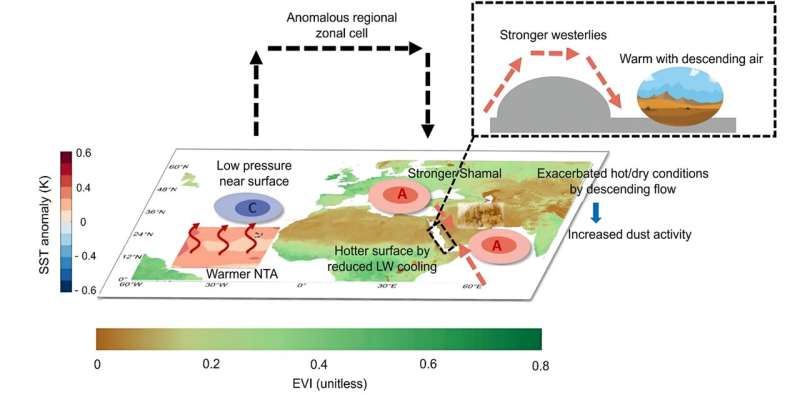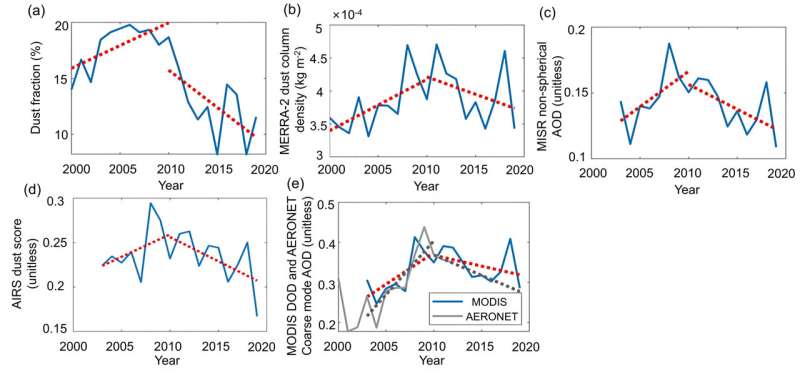This article has been reviewed according to Science X's editorial process and policies. Editors have highlighted the following attributes while ensuring the content's credibility:
fact-checked
trusted source
proofread
Study attributes shift of decadal trend in Middle East dust activities to North Tropical Atlantic variability

A research group led by Associate Professor Jing Li from the School of Physics at Peking University published an article in Science Bulletin titled "The shift of decadal trend in Middle East dust activities attributed to North Tropical Atlantic variability." The study reveals that variability of the sea surface temperature (SST) of the North Tropical Atlantic is the primary driver of the decadal trend shift in Middle East dust activities.
The Middle East, as the world's second-largest dust source, contributes to over 10% of the global dust emissions, with a pronounced peak during the summer season. Transported dust particles influence numerous densely populated regions, spanning from North America to South Asia, and have adverse effects on transportation, health, agriculture, and the environment.
Analysis of multi-source data indicates that over the past two decades, summer dust activity in the Middle East has undergone a significant trend shift. Around 2010, the trend transitioned from a notable increase to a marked decline. The underlying causes for this shift nonetheless remained unclear. Consequently, uncovering the factors behind the trend shift and investigating the specific impact mechanisms is of great importance for the study of global climate and environmental change.
To explore this phenomenon, the research group led by Associate Professor Jing Li in the School of Physics at Peking University employed a combination of multi-source data analysis and global climate model simulations. Their findings revealed a close relationship between the trend shift in Middle East dust activities and changes in the North Tropical Atlantic sea surface temperature (SST).

The correlation coefficient between the two exceeds 0.6, whereas no significant correlation is observed between the former and SST variability of other ocean basins. Concurrently, both Middle East dust and North Tropical Atlantic SST display a similar transition from increasing to decreasing decadal trends for the period of 2000-2019, with turning points occurring around 2010.
Forced simulation experiments utilizing observed North Tropical Atlantic SST, in conjunction with a random forest dust prediction model, successfully reproduced the decadal trend shift of dust activities in the Middle East over the past 20 years.
Further investigations by the research group, involving the diagnosis of meteorological variables and physical processes, revealed that the warming of the North Tropical Atlantic triggers an anomalous local meridional circulation. This promotes air uplift in the North Tropical Atlantic and subsidence in the Middle East. Consequently, the surface high pressure and intensified Shamal winds in the north, generated by the subsiding airflow, foster a hot and dry environment in the Middle East, which is conducive to dust emission and transport.
Around 2010, as the SST in the North Tropical Atlantic transitioned from rising to falling, the trend of Middle East dust activity simultaneously altered.
This research not only uncovers the potential drivers behind the decadal variability of Middle East dust activity but also offers a theoretical foundation for enhancing the predictive capabilities of dust activity in the region and on a global scale.
More information: Guanyu Liu et al, The shift of decadal trend in Middle East dust activities attributed to North Tropical Atlantic variability, Science Bulletin (2023). DOI: 10.1016/j.scib.2023.05.031
Provided by Science China Press





















